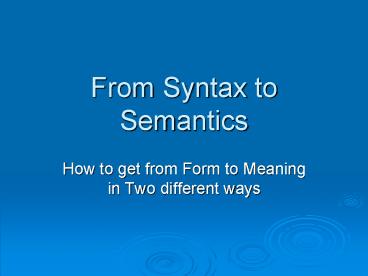From Syntax to Semantics - PowerPoint PPT Presentation
Title:
From Syntax to Semantics
Description:
From Syntax to Semantics How to get from Form to Meaning in Two different ways What is meaning? Connection (grounding) in something outside itself Mental concept ... – PowerPoint PPT presentation
Number of Views:55
Avg rating:3.0/5.0
Title: From Syntax to Semantics
1
From Syntax to Semantics
- How to get from Form to Meaning in Two different
ways
2
What is meaning?
- Connection (grounding) in something outside
itself - Mental concept (ideas)
- Objects and events in the world (true/false)
- Some combination of the above
- Ultimately the success of the program in which
it is embedded
3
Principle of Compositionality
- The meaning of the whole is derived from the
meaning of the parts and the manner of their
combination - John, kiss, Sally
- John kissed Sally.
- Sally kissed John.
4
Semantics -- For our purposes
- Formal representational language that represents
the manner of combination - Lexicon that connects lexical items with some
externally grounded object, the meaning of the
parts
5
Two approaches
- Logical
- Language of formal logic
- Model (set) theoretic grounding
- Interlingual
- Specially-developed InterLingual (IL)
Representation - Ontology to represent word meaning
- To some extent complementary
6
Logical approach
- Predicate calculus and model theory PLUS
- Extra stuff to handle some of the complexities of
natural language, such as - (Scope) Every man loves a woman.
- (Generics) Dogs have four legs.
- (Specificity) John wants to marry a Norwegian.
- (Intension) What if all bald men are tall?
- (Roles) The temperature is ninety and rising.
7
Logical approach ? calculus
- Key idea semantic construction parallels
syntactic construction - John john
- sleep sleep
- John is sleeping sleep(john)
- sleep ?xsleep(x)
- John is sleeping ?xsleep(x)(john)
- Lambda conversion sleep(john)
8
Logical approach possible worlds
- Instead of one model many models
- Each model is a possible world one is
designated as real - Temporal logic
- Modal logic
- Intensional logic
9
IL approach
- Developed in the context of Machine Translation
- Interested in word sense disambiguation
- The pig is in the pen.
- The ink is in the pen.
- Non-literal language metonymy/metaphor
- The White House reported today that
- The business opened its doors in 1928.
- Inferencing for translation mismatches
10
IL approach
- An Ontology, a language-independent
classification of objects, event, relations - A Semantic Lexicon, which connects lexical items
to nodes (concepts) in the ontology - An analyzer that constructs IL representations
and selects (an?) appropriate one
11
IL approach Ontology
- A classification tree in which mother node
contains all below it, and daughter nodes are
distinct (is-a links) - Complications expandable to a lattice, with
non-exclusive daughter nodes - Inheritable features and relations (now looks
more like a dictionary) - Instances can hang from bottom nodes (providing
grounding)
12
(No Transcript)
13
(No Transcript)
14
Semantic lexicon
- Provides a syntactic context for the appearance
of the lexical item - Provides a mapping for the lexical item to a node
in the ontology - Or more complex associations
- Also providing connections from syntactic context
to semantic roles - And constraints on these roles
15
Deriving basic semantic dependency (a toy
example) Input John makes tools Syntactic
Analysis cat verb tense present subject
root john cat noun-proper object roo
t tool cat noun number plural
16
Relevant parts of the (appropriate sense of the
lexical entry for make) make-v1 syn-struc root
make cat v subj root var1 cat
n object root var2 cat
n sem-struc manufacturing-activity agent
var1 theme var2
17
Relevant Extract from the Specification of the
Ontological Concept Used to Describe the
Appropriate Meaning of make manufacturing-activi
ty... agent human theme artifact
18
Relevant parts of the (appropriate senses of
the) lexicon entries for John and tool
John-n1 syn-struc root john cat noun-proper
sem-struc human name john gender male
tool-n1 syn-struc root tool cat n sem-struc
tool
19
The basic semantic dependency component of the
TMR forJohn makes tools is as follows manufac
turing-activity-7 agent human-3 theme set-1 e
lement tool cardinality gt 1
20
try-v3 syn-struc root try cat v subj
root var1 cat n xcomp root
var2 cat v form OR infinitive
gerund sem-struc set-1 element-type refsem-1
cardinality gt1 refsem-1 sem event agent
var1 effect refsem-2 modality modality-
type epiteuctic modality-scope refsem-2 mod
ality-value lt 1 refsem-2 value var2 sem ev
ent
21
Constructing an IL representation
- For each syntactic analysis
- Access all semantic mappings and contexts for
each lexical item - Create all possible semantic representations
- Test them for coherency of structure and content
22
Why is Iraq developing weapons of mass
destruction?
23
Concluding question
- Is all this really necessary?
- Do we need it to do Machine Translation, IR,
IE, Q/A, summarization? - Can we ground the symbols of language without a
special representation of the meaning?
24
Word sense disambiguation
- Constraint checking making sure the constraints
imposed on context are met - Graph traversal is-a links are inexpensive
- Other links are more expensive
- The cheapest structure is the most coherent
- Hunter-gatherer processing































